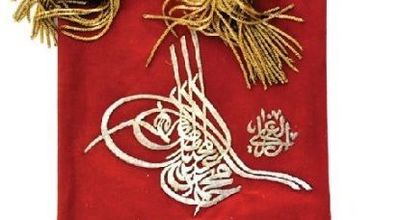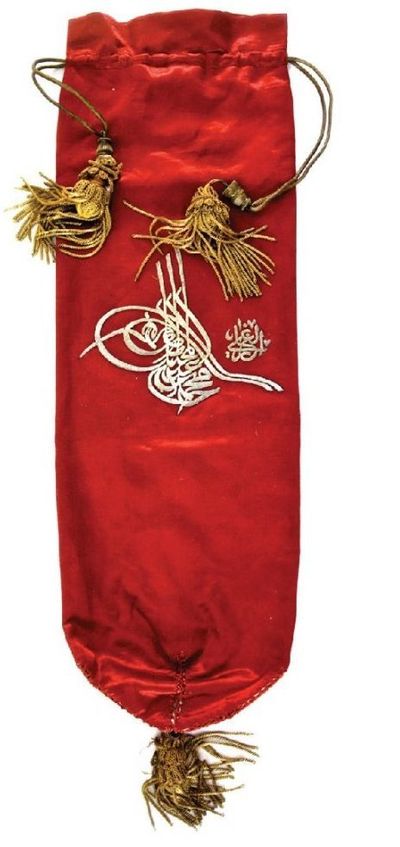
Princely Authority and Sovereignty on Paper
In my previous blogpost I have talked about the circulation of Anglo-Ottoman royal correspondence in Elizabethan society. For this blog I would like to zoom in a little and see how Ottomans negotiate hierarchy, hegemony and faith in their diplomatic relations with the English. To this end I would like to concentrate on inscriptio, the office, name and rank of the person addressed with his or her honorific titles, which is one of the components of farman, any order or edict of the sultan according to Ottoman paleographic and diplomatic standards.

An imperial letter pouch from the Ottoman Archives
Anglo-Ottoman correspondence was not an English-Turkish bilingual affair but a Latin-Turkish one, for the Ottoman court used Latin, the diplomatic lingua franca of the pre-modern world in their foreign correspondence with certain European monarchs. This was in keeping with the Byzantine-Greek tradition which they considered themselves the upholders of. Therefore, Ottoman royal letters were issued in Turkish with their corresponding Latin translations. The first set of Turkish-Latin diplomatic documents sent to Elizabeth I from Murad III that marks the commencement of official relations does not survive today. Instead of the Turkish original there is a chancery copy in Istanbul that for the purpose of the copy does not include the original inscriptio but a brief address line as follows:

[To Elizabeth, the queen of the wilāyet of England, tis the command]
The phrase “wilāyet of England” immediately puts Elizabeth on a lower rank than the Ottoman sultan but on par with other European monarchs, who were addressed similarly. A wilāyet designates any governorship, large or small. Murad’s official title featured no less than thirteen wilāyets. However, the translation of wilāyet into Latin as “Regni” (kingdom) meant that this difference was not apparent in the Latin version. It is not in the usual letter form addressed to heads of state, but in a command normally issued to the subjects of the sultan. Murad III’s letter that guarantees the safety of English merchants and tradesmen doing business in and between ports in Ottoman dominions mentions that likewise merchants from Venice, France and Poland freely trade under the protection of the sultan. From the reference the impression is that the image of England is somewhere between these three, at least initially. The satin bag and silver capsule in which the letter is instructed to be wrapped according to the note at the header indicate a minor ranking, as minor rulers such as Caucasian princes had their letters sent in such wrapping. This however would improve in the following correspondence and the wrapping would upgrade to a brocade bag fastened with a golden capsule. Murad concludes his command wishing prolonged friendship and complete devotion from Elizabeth.
The letter that shortly followed this command, which if it survived would have been a great evidence of the historical roots of the matchmaking skills of Turks is reported by the Spanish ambassador to London, Mendoza to Philip II on November 28, 1579: “This queen has received another letter from the Turk … of the king of France with whom he requests her to be as friendly as she can. He says that, by reason of his friendship to the king of France, he will be pleased to hear of her marriage with his brother.” From the Latin copies of these two letters procured by both Spanish and French ambassadors thanks to their espionage operations, ending up in Vienna and Paris respectively, it is possible to establish an equivalent of the inscriptio of this:
Splendore at Gloria fulgidissima Elizabeth Sacra Regia Maiestas et Princeps magnanimorum Iesum Cmotantium, Serenissima moderatrix negociorum et rerum omnium plebis et familiae Nazarenorum sapientissima, nubes pluuiarum gratissima, fons splendoris et honestatis dulcissima, Domina et haeres perpetuae beatitudinis et gloriae Incliti Regni Angliae
[In greatness and glory most renowned Elizabeth, most sacred Queene, and noble prince of the most mightie worshippers of Jesus, most wise governor of the causes and affaires of the people and family of Nazareth, cloud of most pleasant raine, and sweetest fountaine of noblenesse and virtue, ladie & heire of the perpetuall happinesse & glory of the noble Realme of England]
Murad III’s third address to Elizabeth was his reference letter for two of his agents travelling to England to make purchases for his household. It opened with a very brief inscriptio, “to the Queen of England” to which she replied “Most renowned Caesar! Most invincible Imperial Majesty.” Therefore, the earliest date on which we come across a full inscriptio in Latin for Elizabeth is the treaty letter, (ahd-name) dated September 1580:
Illustrissima gloriosissimaque Magnanimorum lesum commitantium Elizabeta Regina et singularis Cristianae plebis et familiae Incliti Regni Angliae princeps
Although both feature common expressions, the first Latin inscriptio is significantly more elaborate than the second one which may not be necessarily because the original Turkish was so, but because the court translator Mustafa beg might have taken the liberty to make a more embellished translation for his own personal reasons as he was seeking favours from the queen. In all Ottoman letters dated between 1580 and 1601 that survived in Turkish the inscriptio for Elizabeth almost never changes, except for occasional praise for her chastity.

[The pride of the women who follow Jesus, the most excellent of the honourable ladies among the Messiah’s people, the arbitress of the affairs of the Christian community, who trails the skirts of majesty and gravity, the Queen of the principality of England – may her end be good.]
Therefore, it is most likely that the first document issued to Elizabeth in the form of a command also opened with the same inscriptio as the rest of the diplomatic letters that followed it. In fact, the inscriptio designed for Elizabeth was in the same format as “the title for the kings of France, Poland and Austria” as listed in the clerk of the signet to Murad III, Nişancı Feridun Bey’s Mecmuat-ı Münşeat-üs Selatin (1575), a comprehensive work that contains around two thousand copies of royal letters issued in the Ottoman court from the first sovereign until Murad III. It was tweaked and adjusted according to her gender by borrowing a few phrases from the “title for the mothers of the non-Muslim kings” also listed in the same volume as follows:

To the mothers of infidel sovereigns
The model for the great women who follow Jesus, the chief of the honourable ladies amongst the Messiah’s people, the arbitress of the affairs of the Christian community, the compassionate mother of our friend padishah of France so and so lady who is his respected counsel and deputy in the affairs of his lands - may her end be good

Title to be writ for padishah of France, kings of Vienna and of Poland and of environs:
The pride of all Christian Princes, the most excellent of honourable men of Messiah’s people, the arbitrator of the affairs of the Christian community, who trails the skirts of majesty and gravity, so and so person – may his end be good
When James I ascended to the throne the above formulae would be followed exactly in the royal letters addressed to him. What stands out in this formulation is the concluding benediction which would literally translate as “may your end be good”. Nonetheless, it really means “may you ere death receive the grace of God”. This benediction, commonly used by Ottomans for non-Muslims, voices the hope that the addressee would give up her final breath as a faithful Muslim for this is the ultimate good ending in which one can receive the grace of God, from a Muslim point of view. In this context i.e., from Murad to Elizabeth it subtly implies that she would enter the fold of Islam before she dies.
This epistolary protocol shows how the Ottoman court used benedictions and various terminologies in diplomatic correspondence as a way of delegating non-Muslim potentates a place in the spiritual-cultural-social hierarchy of an inherently Muslim world and it opens a window for the modern reader into the Islamic world’s global affairs before secular humanism replaced religion as the cohesive force within civilized society. In my next blogpost I will explore Anglo-Moroccan correspondence during the Elizabethan reign.
------------------------------------------------------------------------------------------------------
REFERENCE
For all diplomatic documents see Appendix in Susan Skilliter, William Harborne and the Trade with Turkey, Oxford University Press (1972)
For Feridun Bey, Münşeat-üs Selatin, Darüttıbattil'âmire, Istanbul (1583) https://curiosity.lib.harvard.edu/islamic-heritage-project/catalog/40-990078556280203941

